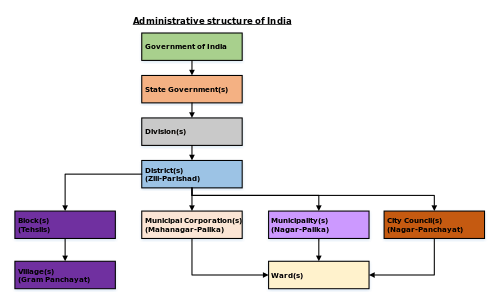Community development blocks in India
In India a community development block (CD block) is a rural area administratively earmarked for planning and development.[1] The area is administered by a Block Development Officer, supported by several technical specialists and village-level workers.[2] A community development block covers several gram panchayats, the local administrative units at the village level.

In some states of India, CD blocks are the third level administrative units (equal to tehsils in other states). Bihar, for example, has 38 districts, 101 sub-divisions (sub-districts) and 534 CD blocks.[3] West Bengal has 18 districts and 341 development blocks.[4]
History
The concept of the community development block was first suggested by Grow More Food (GMF) Enquiry Committee in 1952 to address the challenge of multiple rural development agencies working without a sense of common objectives.[5] Based on the Committee's recommendations, the community development programme was launched on a pilot basis in 1952 to provide for a substantial increase in the country's agricultural programme, and for improvements in systems of communication, in rural health and hygiene, and in rural education and also to initiate and direct a process of integrated culture change aimed at transforming the social and economic life of villagers.[6] The community development programme was rapidly implemented. In 1956, by the end of the first five-year plan period, there were 248 blocks, covering around a fifth of the population in the country. By the end the second five-year plan period, there were 3,000 blocks covering 70 per cent of the rural population. By 1964, the entire country was covered.[7]
States with Blocks (3rd level administration)
| State | CD Block | Number of CD Blocks |
|---|---|---|
| Bihar | CD Block | 534 |
| Haryana | CD Block | 140 |
| Jharkhand | CD Block | 263[8] |
| Odisha | CD Block | 314 |
| Tripura | CD Block | 58 |
| Uttarakhand | CD Block | 95 |
| West Bengal | CD Block | 341[9] |
See also
References
- Maheshwari, Shriram. "Rural Development and Bureaucracy in India". The Indian Journal of Public Administration. XXX (3): 1093–1100.
- Sharma, Shailendra D. (1999). Development and Democracy in India. Boulder, Colorado: Lynne Rienner Publishers, Inc.
- "Bihar receives 11th National e-Governance Award (Silver Medal) 2008 | National Informatics Centre". www.nic.in. Retrieved 19 September 2019.
- "INTRODUCTION". Retrieved 19 September 2019.
- Report of The Grow More Food Enquiry Committee. Government of India Ministry of Food and Agriculture. 1952.
- "First Five Year Plan". Planning Commission. Retrieved 10 September 2018.
- "The Failure of the Community Development Programme in India". Retrieved 6 April 2010.
- "Names of Blocks of Jharkhand". Jharkhandi Baba. 21 October 2017. Archived from the original on 21 October 2017. Retrieved 21 October 2017.
- "Census India, West Bengal" (PDF). Retrieved 20 April 2020.